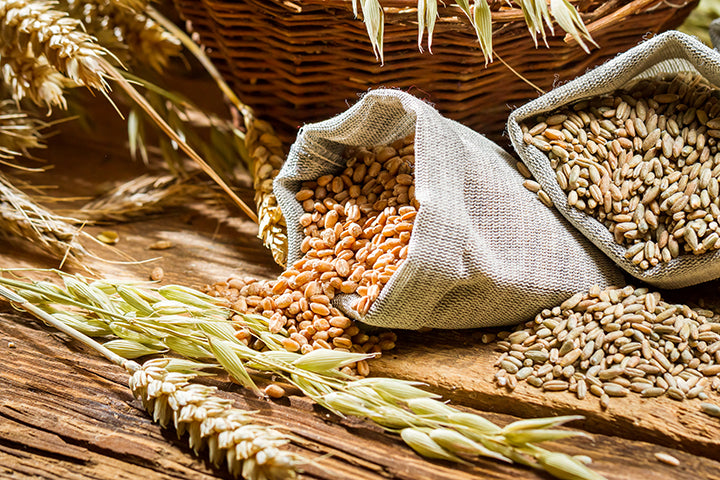
There are plenty of fad diets out there. And with every fad diet, there's usually a villain—like carbs, fats, sugar, and gluten, to name just a few. Sometimes, these villains are legitimately unhealthy (sorry, sugar). Other times, these so-called bad guys are misunderstood, and people who buy into the fad diets deprive themselves from the nutritional benefits. Grains are some of the more well-known food villains. Whole 30 and most forms of paleo diets are two examples of popular diets that call for a ban or limit on grains. However, grains can actually be the good guys, if you choose the right ones.
What are grains, anyway?
Grains include rice, wheat, oats, cornmeal, and barley to name a few. (Although cooked and consumed like a grain, quinoa and buckwheat aren’t technically grains). Foods like bread, pasta, oatmeal, tortillas, couscous and many others are considered grain products. Cakes, cookies, pancakes, and other sweet foods are also made from grains. Depending on the diet, there are a variety of reasons grains in general are considered “bad”:- The main issue people have with grains is that they’re highly processed. Grains are actually the granddaddy of processed foods—milled wheat was the first processed food! And highly processed usually means:
- They’re not as rich in nutrients. The process of milling grains strips them of most of their nutritional content. True, most products are “enriched” or “fortified,” meaning vitamins and minerals have been added back to the food. Ultimately, however, they still hang pretty low on the nutrient density scale.
- Unless they’re organic, grains are heavily sprayed with pesticides and many (especially wheat) are genetically modified.
- They spike insulin levels and may contribute to diabetes and obesity when other, healthier foods aren’t consumed.
- They contain phytic acid, which is toxic to the body. This is actually not true and .
- They all contain gluten, which everyone should avoid (also not true.)
Before you hop on the grain-free bandwagon, it’s important to note that there are actually two different types of grains: whole grains and refined grains.
Whole Grains vs Refined Grains
In their natural state, there are three parts to a grain:- Bran: Outer layer that contains mostly healthy fiber, and a few healthy fats
- Endosperm: Middle layer comprised mostly of starchy carbs, with a little protein
- Germ: The most nutritious core of the grain
Refined grains
Refined (or milled) grains strip the grain of the bran and germ (the two best parts!) and leave the endosperm. Pretty much all white flour products like cookies, cakes, pastries, crackers, most breakfast cereals, white bread, and more and white rice fall into this category. Refined grains are the villains of the grains group and have been linked to a number of serious health conditions. Because they are nutrient poor, refined grains are more or less empty calories. Being low in protein and fiber also means they cause the blood sugar to spike, leading to hunger and overeating once they drop. Studies have shown they also increase visceral fat (the fat around the organs), lead to a greater risk of diabetes, and are linked to obesity.
Whole grains
Whole grains, on the other hand, include the entire grain. A grain can still be considered whole after processing (for example, by cracking, crushing, rolling, or cooking) as long as all of the bran, endosperm, and germ of the original kernel are all present. Some of the most common types of whole grains and pseudo-grains include barley, buckwheat, corn, oats, oatmeal, quinoa, brown and colored rice (but not white), rye, and wheat.
Nutritional Content of Whole Grains
Unlike refined grains, whole grains can be part of a nutritious, health-supporting diet. Why?
They’re rich in fiber.
Whole grains are rich in fiber, which works as a natural appetite suppressant, as seen in a number of studies. It’s also been linked to a whopping 40% lower risk of heart disease. Whole wheat pasta and quinoa, which both have about 6 grams of fiber per serving, are good sources of high-fiber whole grains.
They’re excellent sources of complex carbohydrates.
We’ve been trained to think that carbs are bad for you, especially when trying to lose weight. Unlike simple sugars (like table sugar, honey and agave) complex carbohydrates are digested and absorbed slowly into the system, which helps avoid the blood sugar spikes and lower energy that occurs from sugary foods or refined grains. They are a rich source of energy, especially if you’re an avid exerciser.
They contain key vitamins and minerals.
Whole grains contain important nutrients, including B vitamins like riboflavin and folate, and minerals like iron, magnesium, phosphorous, manganese and selenium. Quinoa is rich in folic acid, which is essential for healthy cell development and crucial in the development of a healthy brain and spine in utero.
They’re ideal for vegetarians.
Vegetarians often get protein and other nutrients from whole grains.
Health Benefits of Whole Grains
The health benefits of whole grains are well-documented. For starters, you’ll live longer. One Harvard study found that for every serving of whole grains consumed, participants lived 5% longer on average. For participants with cardiovascular disease, that number jumped to 9% longer. A diet rich in whole grains is also good for the heart. One study showed that those who ate 3-5 servings of whole grains each day had a 21% lower risk of heart disease. Other studies have shown a reduction in risk up to 28%. Whole grains are also associated with a lower chance of developing type 2 diabetes, in some cases by up to 30%. Diets that contain at least 3-5 servings of whole grains a day are also linked to better cognitive function. “Grain brain” is also good for kids. One study found that children who ate a breakfast that included whole grains scored significantly higher in test scores than children who did not. Another important health benefit of whole grains is less inflammation. One study observed the health effects of 37 different food groups and found that whole grains had the strongest anti-inflammatory effect of all the foods studied.
What About Gluten?
It’s worth mentioning gluten when talking about grains as well. Gluten is a type of protein found in wheat, barley and rye that has received considerable attention lately. Gluten-free diets are all the rage, and many websites and books have painted gluten out to be another nutritional villain. However, unless you have celiac disease or a gluten sensitivity, avoiding gluten is not necessary. If you do have celiac or are gluten sensitive, you can still reap the benefits of whole grains. Since gluten is only found in wheat, barley, rye, and occasionally oats, most grains are naturally gluten-free. Quinoa, rice, corn, and millet are just a few gluten-free whole grains. (Keep in mind that some oats become contaminated during growing and processing, so make sure they’re certified gluten-free.)
Is rice protein a grain?
Although derived from whole rice grains, rice protein is technically no longer considered a grain. In order to make it a rich vegan protein source, over 85% of the carb content and other nutrients must be removed. With an entirely different nutritional profile to rice grains, the benefits would be protein-related rather than whole grain related.
Grains—The Bottom Line
Despite what you may read or hear, grains are not the bad guys—as long as they’re whole grains and not refined. In fact, whole grains can provide a ton of health benefits and even help you live longer. So skip the fad diets and stick with whole grains. If you do decide to limit grains, take extra care to get nutrients from other sources.
Written By: Jill Overmyer
Reviewed & Edited By: Scarlett Full, in-house Registered Dietitian
